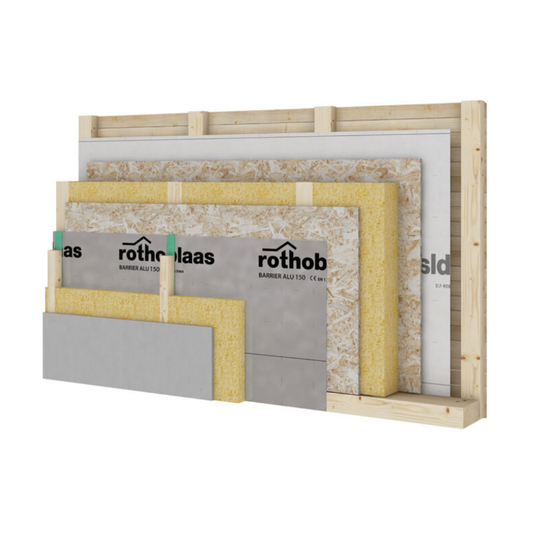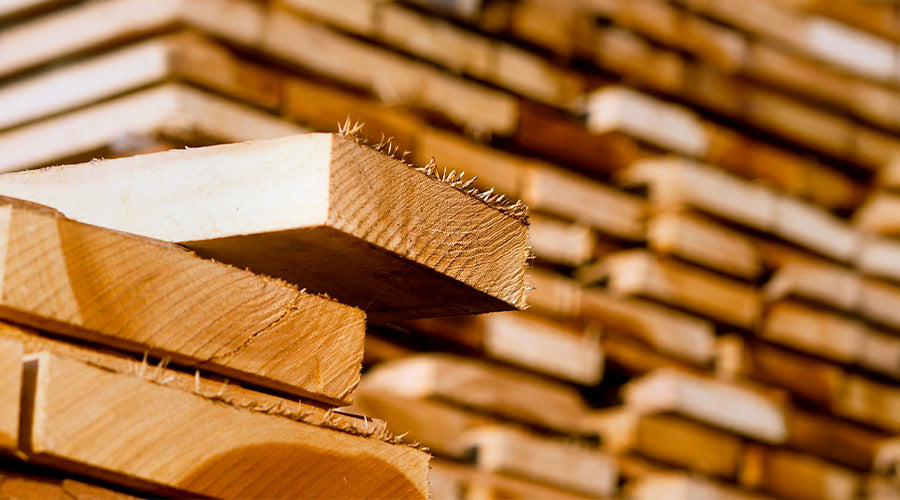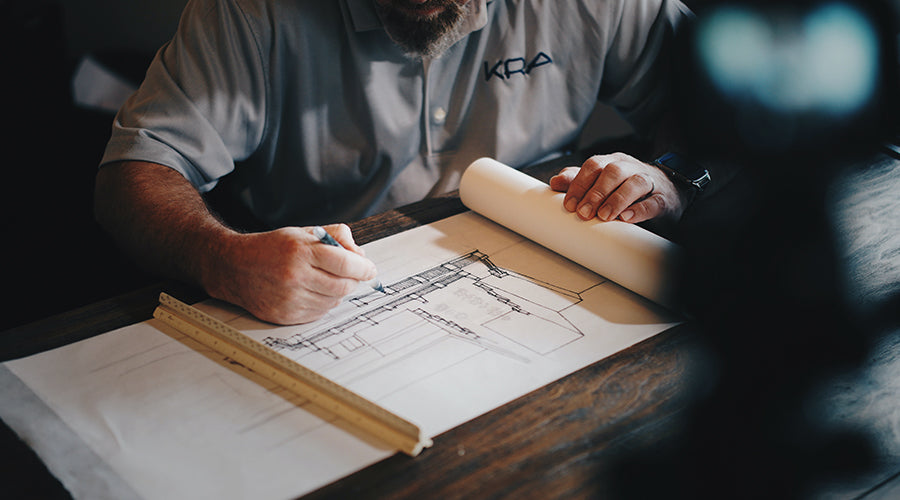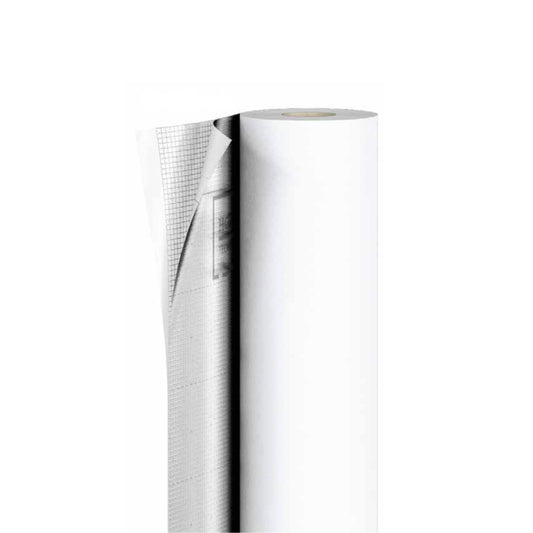
Vapour Barriers
High-performance vapour barrier membranes
A vapour barrier is a critical component in modern construction, preventing moisture-related damage and improving insulation performance. Whether used as a vapour barrier for walls, a flat roof vapour barrier, or a breathable vapour barrier, these membranes help regulate the movement of moisture, reducing the risk of condensation, damp, and mould growth.
In timber buildings, controlling moisture transfer is essential to prevent rot, insulation failure, and structural deterioration. By selecting the right vapour barrier membrane, builders can ensure long-term stability and energy efficiency for both walls and roofing systems. Shop vapour barriers now.
-
 Sold out
Sold outBarrier ALU 150
Regular price £206.64 GBPRegular priceUnit price / per -
Stop House ALU Net 100
Regular price £78.60 GBPRegular priceUnit price / per
What is a vapour barrier?
A vapour barrier is a membrane designed to limit the passage of moisture vapour through walls, roofs, and floors. It helps prevent water vapour from moving into insulation or timber structures, where it could condense and cause damp-related damage.
Types of vapour barriers
- Standard vapour barriers – non-breathable membranes that create a complete seal, stopping moisture from passing through.
- Breathable vapour barriers – designed to allow some vapour movement, helping to manage condensation in ventilated structures.
Vapour barriers are typically made from polyethylene sheets, bitumen-backed membranes, or foil-faced insulation and are positioned on the warm side of the insulation to prevent warm air from meeting a colder surface and condensing into water droplets.
How do vapour barriers work?
Vapour barriers work by slowing or completely stopping moisture diffusion from one side of a structure to the other. This prevents condensation buildup within insulation, timber, or roofing materials, reducing the risk of mould growth, rot, and reduced thermal efficiency.
Key functions include:
- Blocking moisture transfer – prevents humid indoor air from reaching cold surfaces where condensation could form.
- Enhancing insulation performance – keeps insulation dry and fully functional, preventing moisture-related deterioration.
- Protecting structural components – reduces the risk of timber warping, decay, and corrosion in metal fixings.
In roofs and walls, a vapour barrier membrane is usually placed on the warm side of the insulation to prevent internal humidity from penetrating and condensing within the structure.
What are the benefits of vapour barriers?
- Prevents condensation and damp damage - By stopping moisture vapour from passing into insulation or timber, vapour barriers reduce the risk of mould, damp patches, and rot.
- Improves energy efficiency - A properly installed vapour barrier membrane keeps insulation dry and effective, helping to maintain indoor temperatures and lower heating costs.
- Protects timber and structural integrity - Excess moisture can cause timber to swell, weaken, or decay over time. A vapour barrier helps maintain the stability and durability of the building.
- Reduces maintenance costs - By preventing moisture-related damage, vapour barriers help reduce the need for expensive repairs to walls, roofs, and insulation.
- Enhances indoor comfort - By reducing moisture fluctuations and temperature variations, a vapour barrier helps create a more stable and comfortable indoor environment.
What to consider when choosing a vapour barrier?
1. Type of vapour barrier
- Non-breathable vapour barriers – completely block moisture movement, ideal for airtight buildings in cold climates.
- Breathable vapour barriers – allow some vapour to escape, reducing condensation risks in ventilated structures.
2. Placement and installation
- Walls – installed on the warm side of the insulation to prevent condensation within the cavity.
- Roofs – required in warm roofs but may not be necessary in cold roofs, depending on ventilation.
3. Climate and building conditions
- In humid environments, a vapour-tight membrane is essential to stop excessive moisture buildup.
- In mixed climates, a vapour-permeable barrier may be needed to allow controlled moisture movement.
4. Compatibility with insulation and building materials
- Ensure the vapour barrier is suited for use with the insulation, timber, and wall or roof system in your building.
5. Durability and fire performance
- Some vapour barriers come with fire-retardant properties, ensuring compliance with building regulations for fire safety.
How to install a vapour barrier?
Step-by-step guide to installing a vapour barrier
1. Preparing the surface
- Ensure the wall or roof structure is dry and free from debris.
- Check for existing moisture issues before installation.
2. Rolling out the vapour barrier
- Start from the bottom of the wall or roof and work upwards.
- Lay the vapour barrier sheets horizontally, ensuring overlaps of at least 100mm.
3. Fixing and sealing the membrane
- Secure the vapour barrier with staples, battens, or adhesive.
- Use vapour barrier tape to seal all overlaps, penetrations, and edges.
4. Installing insulation and finishing layers
- For walls, apply insulation and finish with plasterboard or cladding.
- For roofs, install insulation and complete with roofing materials.
Correct installation ensures that the vapour barrier performs effectively, preventing air leaks and moisture penetration.
Do I need a vapour barrier on…?
Hot roofs:
Yes. In warm roof systems, a vapour barrier is necessary to prevent condensation within the insulation. It is placed on the interior (warm side) of the insulation to block moisture from entering.
Cold roofs:
Not always. In cold roofs, ventilation is usually the preferred method for moisture control. Instead of a vapour barrier, a breathable underlay or ventilation system may be used to allow moisture to escape naturally.
Using a vapour barrier in a cold roof without proper ventilation can trap moisture and lead to serious condensation issues.
A vapour barrier is an essential element in moisture control, helping to prevent condensation damage, improve insulation performance, and protect timber buildings. Whether you need a vapour barrier for walls, a flat roof vapour barrier, or a breathable vapour barrier, choosing the right solution ensures long-term building durability and energy efficiency.
By understanding how vapour barriers work, where they should be installed, and which type is best for your roof or walls, you can create a well-protected, moisture-resistant, and thermally efficient structure.
Timber build advice:
-

How to soundproof a timber house?
Find out how -

How to connect timber to…..?
Find out how -

How to fix timber build noise issues?
Find out how
Need advice on your timber project?
Our team of experts are ready to assist you with any questions or guidance you may need for your timber construction. Whenever you're ready to delve deeper into the possibilities, feel free to reach out to us.





